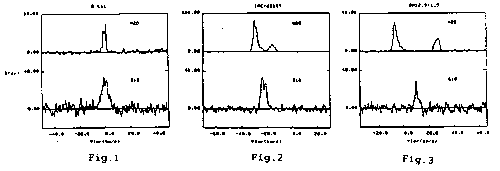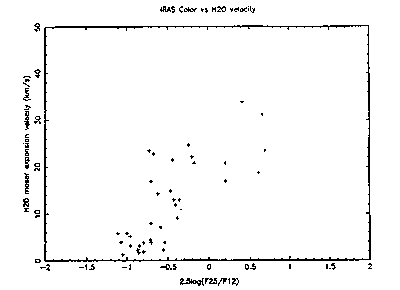
H20 (Top) and SiO (Bottom) maser spectra of R LMI ( Fig.1), IRC+60169(Fig.2) and OH12.8-1.9(Fig.3)
A portable acousto-optical spectrometer (AOS) became available at Kashima. The AOS uses an optical diode laser and had been developed in Nobeyama Radio Observatory (Miyaji 1991). The frequency resolution and the total band width are 40 KHz and 40 MHz, respectively. The AOS is used to check the pointing at the VLBI observation time of maser sources. A new automatic maser survey software was developed by the author and a snapshot 22 GHz H20 and 43 GHz SiO (J=1-0,v=1) maser survey was made between 1991 April 26 and May 11 using the AOS and with 34 m radio telescope at Kashima. About 200 stars were selected from the catalog of stellar masers by Benson et al. (1990) and about 160 late type stars were observed almost simultaneously with both two maser transitions.
By comparing those spectra, a systematic change of H20 maser spectra was found in M type stars. In figures' 1-3, H20 and SiO (J=1-0,v=1) maser spectra toward three stars (a visible Mira variable R LMI, a near infrared source IRC+60169, and a far infrared source OH12.8-1.9) are shown. Double peaked H20 emissions are seen in IRC/AFGL objects and OH/IR stars and as shown in figure 4, the expansion velocity of the H20 maser is found to be correlated with the IRAS color temperature derived from 12 um and 25 um intensities.


The oxygen-rich M type stars are thought to evolve in the sequence of Mira variable, IRC/AFGL objects, and OH/IR stars. In this evolutionary sequence, the mass-loss rate increases and the IRAS two colors (12 um and 25 um) becomes cooler (e.g., Van der Veen 1989, Bowen and Willson 1991). Therefore our result shows that the H2O maser emitting regions are expanding from the star with the evolution of the central star. Since Cooke and Elitzur (1985) calculated that the location of 22 GHz H20 maser emitting region moves out with the mass-loss rate increase based on the collisional excitation model, our observational result is simply explained by the collisional excitation model. Thus we can say our observation is a strong evidence of the collisional excitation of 22 GHz H20 maser in late-type stars.
We are planning VLBI observations with KNIFE (Kashima Nobeyama Interferometer) for more detailed study of stellar masers in this and early next year.